
The Pyramids of Giza are amongst the most recognizable built structures on earth. I don’t know how many hundreds, or most likely thousands, of photos I have seen of The Big Triangles, nor how many times I have seen them on tv. Having traveled to Egypt, I was wondering if the ‘familiarity’ of the pyramids would detract a little from seeing them in real life. I also wondered if the fact that the Cairo sprawl nearly reaches the paws of the Sphinx would also take away from the experience somewhat. I remember as a kid seeing a photo of someone looking out the window of KFC at the pyramids and being horrified.
I would soon find out the answers, as my cab driver boldly asserted himself as we battled our way to Cairo’s outer south-east. As we neared my accommodation, I hesitated to search for the pyramids through the window. I wasn’t sure I wanted my first view of the ancient structures to be between drab high-rise flats. Despite my efforts, I caught a glimpse of one of them in the gap between the horizon and a freeway overpass. I quickly looked away.
Next day I packed food and water and started the short, 20 minute walk from my flat to the Giza Plateau. Passing under the freeway, I got my first look at the Pyramids, which soared above the dusty horizon. I felt a jolt of excitement…I was going to the Pyramids!
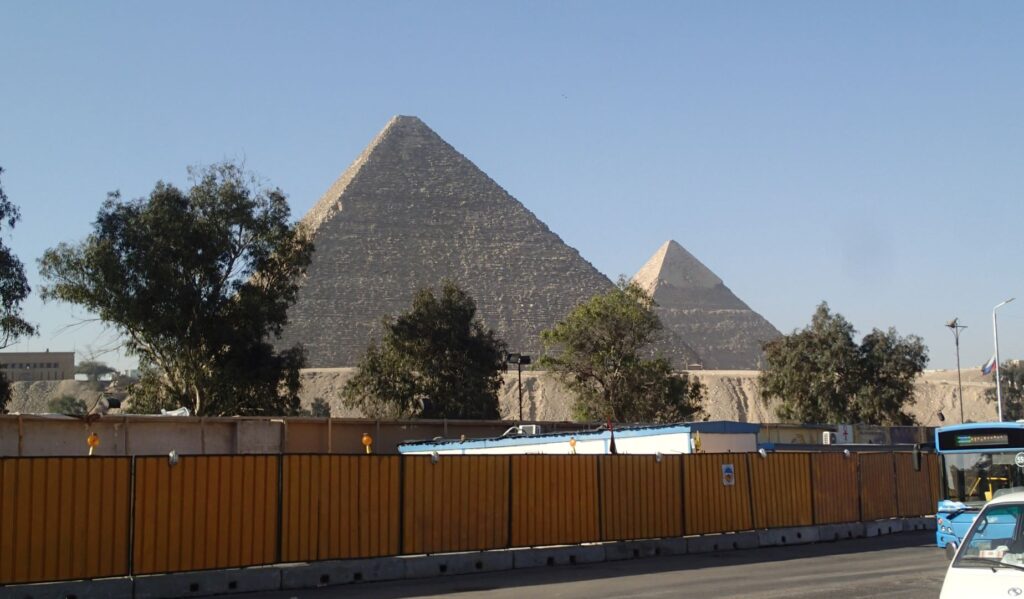
I passed through the first police checkpoint, which was the usual collection of officers, firearms, riot gear, bomb detection kit, barricades and vehicles, and climbed the hill to the plateau. It was here I encountered my first scam, sadly a experience that would play out over and over again during my visits.
I don’t want to dwell on what is a significant bummer during a visit to this ancient place. Suffice to say all the stories of scams, attempted fraud and coercion you hear about are true. I am a patient and polite person, but I eventually lost my cool with the liars, cheats and corrupt officials. I am not referring to the transport workers and tour guides who ask constantly if you require a horse, camel, carriage or guide. Yes they might seek to overcharge, but they are providing a service. Just those who try to take your cash through deception and pressure.
Reaching the ticket window, I found they did not take card. I was starting to realise that Egypt is a cash economy, from street vendor to government department. Having insufficient cash, I was directed back down the hill to a nearby luxury hotel which had an ATM. Though I was frustrated in having to delay my entry to the monuments, I did get a great view of the Pyramids of Giza from the hotel grounds.
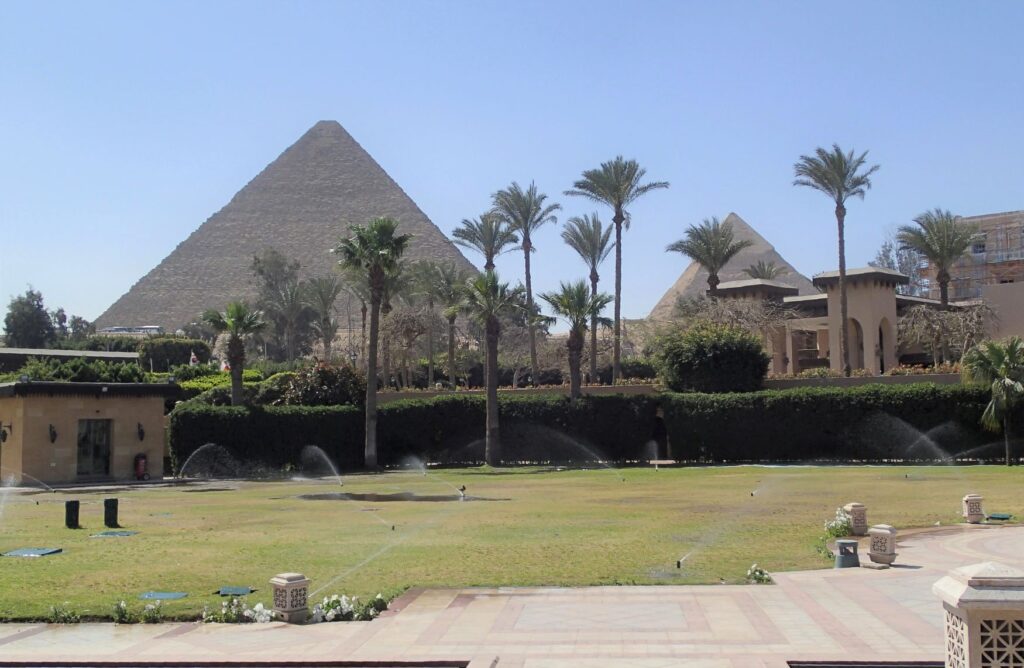
Finally having gained entry to the reserve, I walked up the steep path towards the Great Pyramid of Khufu. All doubts about how I would feel when I saw the monument for myself disappeared. It was breathtaking. I soon forgot the megalopolis of Cairo too, as I became completely ensconced in exploring this amazing place.

The largest of the three huge pyramids at Giza, the Pyramid of Khufu was the final resting place of King Khufu, who handed in his knife and fork circa 2566BC. A staggering amount of limestone tonnage went into building this massive monument, which the experts reckon took 10-20 years. Originally the Pyramid was finished with an outer covering of fine limestone, giving it a smoother appearance. However this stone was later ratted for other building projects when the glory of Pharaonic times had faded into the past.
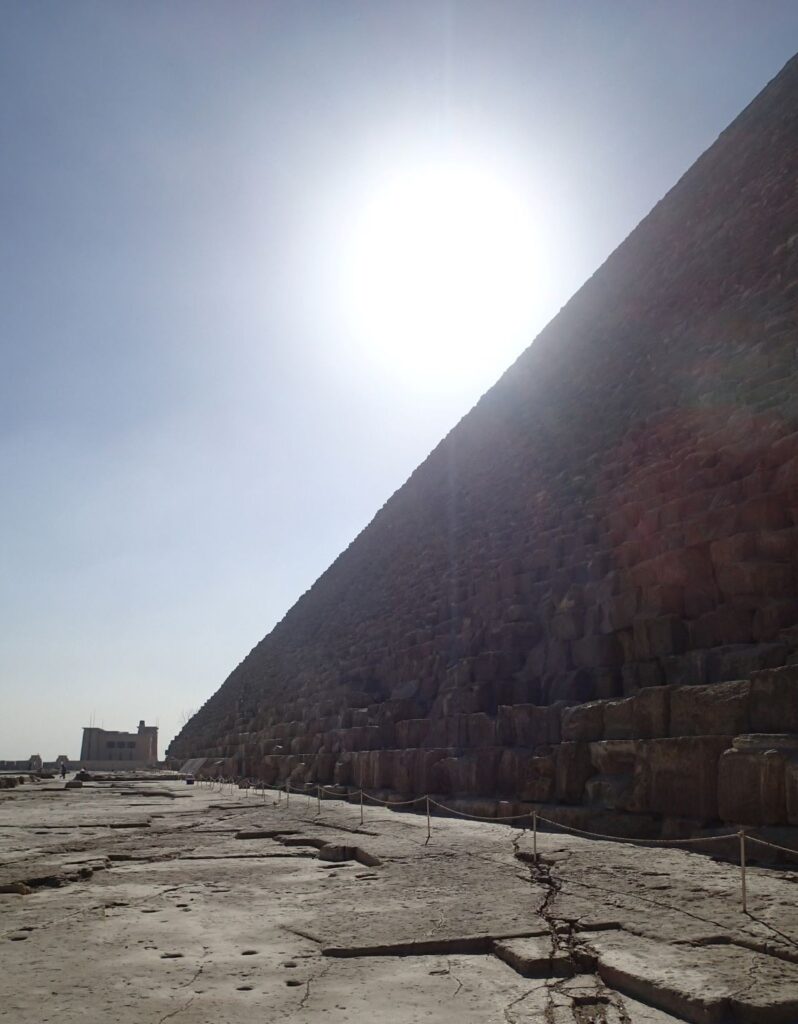
I had paid extra to enter the Great Pyramid, so climbed the stairs over the massive limestone blocks to the entrance. After showing my ticket, I paused at the opening. Not only was I visiting the Pyramids, I was about to enter the biggest of them all!
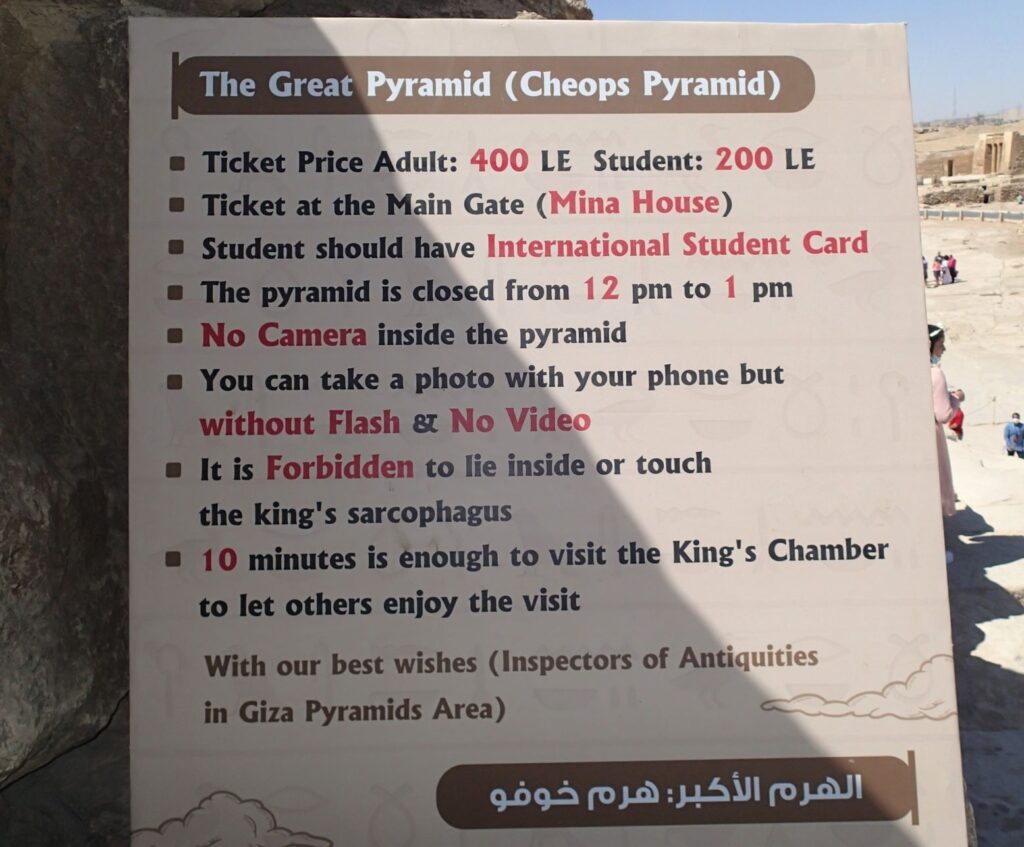
Grinning like an idiot, I followed a passageway to a long, steep timber ramp fitted with rungs. Stooping down, I began to climb towards the heart of the ancient monument.
Do’s and Don’ts for your visit inside the Great Pyramid. Cheops is the Greek name for King Khufu

After an uncomfortable climb through the narrow tunnel I reached the grand gallery, with its 26 foot high ceiling providing my back and knees with a much needed break. Another climb and I was at the top of the gallery, where a passage ended in a low gap.

I squatted down and squeezed through. It was warm and humid inside the Pyramid, and after the climb I’d worked up a sweat. Straightening up, I let my eyes adjust to the gloom. I was in the burial chamber of King Khufu. The rectangular room was lined with Aswan red granite, smooth and undecorated, which had been mined and transported about 700km by boat. The King’s empty stone sarcophagus stood at the far end of the chamber. I was standing inside 4500 years of history.
The Grand Gallery was indeed
I noticed a group of women visitors, many wearing Egyptian jewellery and clothing reminiscent of traditional royal garb, lined up around the walls of the room. Some were seated cross legged, with their hands held palms together before them in the pose of prayer. Others had their hands splayed and placed against the walls.
A woman, who turned out to be the leader of the tour group, intoned: ‘If this is your first visit, I suggest you take a moment to centre yourself before attempting to interact with the structure’. One of the women started playing meditation-style music from her phone. Several members of the group approached the sarcophagus, and placed their hands upon the ancient granite. Others squatted down and leant their backs against it, and one draped herself across the open coffer.
The security guards walked around saying ‘no praying, no praying’ and asking those who had sat down to stand. Shortly after, they asked the group to leave whilst pointing at their watches to indicate that the allotted 10 minutes permitted within the tomb had expired. No-one moved, and a discussion took place between the leader and the guards. The guards then walked around clapping their hands and attempting to usher the group out. I left at this point.
Having worked in protected area management for many years, I have encountered similar groups like this on many occasions. Although they proclaim a special connection and affinity with a place that is not part of their own culture, they then proceed to break management regulations put in place to protect the integrity of the site and the experience of other visitors.
The Pyramid of Khafre sits a short distance off the south-west corner of the Great Pyramid. Khafre was Khufu’s son, and ruled Egypt and it’s empire for about 25 years. Khafre had two great loves – statues, and himself. Consequently he had more statues built than any other ruler of this age, most of which were in his own image. It is believed that Khafre also built the Sphinx, and true to form stuck his own face on it. Khafre’s pyramid still retains a cap of the fine limestone outer shell that once covered the entire structure.
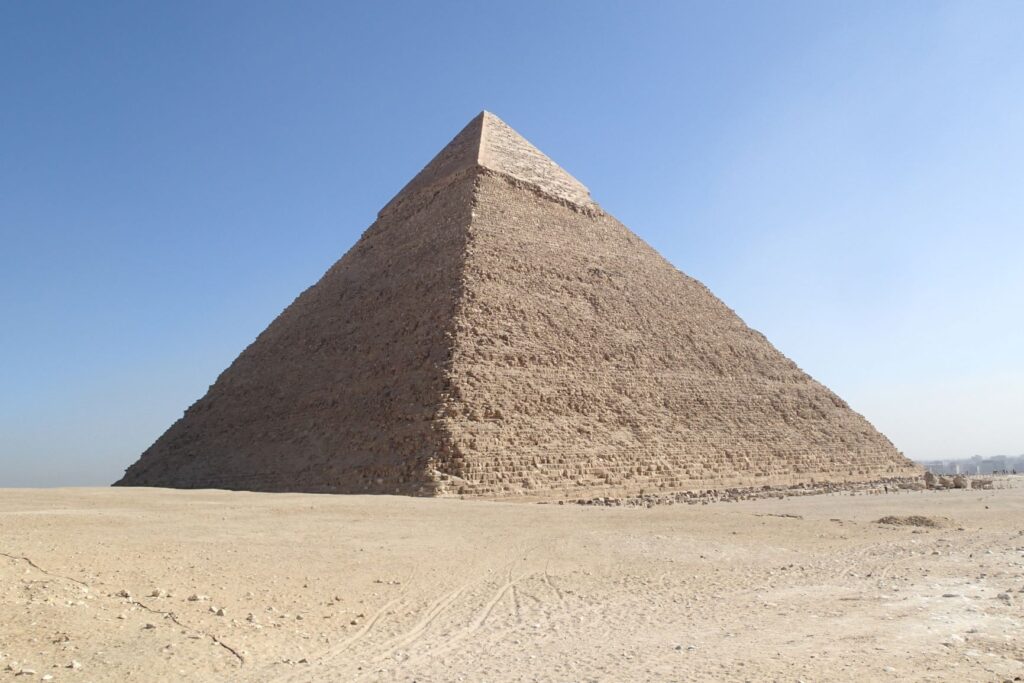
I had also purchased a ticket to enter Khafre’s Pyramid, and made the short walk over from the his father’s monument. Entering from the bright sunlight and reflected glare, I descended down a ramp and along a passageway, heading deep into the massive structure.

After climbing another ramp, I arrived at Khafre’s burial chamber. The King’s sarcophagus lay at the end of the rectangular room surrounded by huge red granite blocks. It is amazing to think that this enormous Pyramid was built to hold one sarcophagus, and just one mummified body. Less than two cubic metres of space within an estimated 1.6 million cubic metre structure.
Spooky

It turns out I had timed my entry into the Pyramid to coincide with the same group I had encountered in Khufu’s burial chamber. A verbal exchange between the tour leader and staff was heating up, as once again the security guards attempted to get the group to leave. I attempted to ignore the stoush that was unfolding, and reminded myself that I was standing in a burial chamber deep within one of the Pyramids of Giza.
After leaving the chamber I walked out into the glare, and found a shady spot for lunch on one of the Pyramid’s enormous blocks. As I ate the women emerged, clearly annoyed at being asked to leave the tomb. One, dressed in ancient Arabic style clothing and wearing Egyptian jewelry on her forehead and upper arms, was complaining loudly and demanding a written apology.
Seeing the Pyramids of Giza, and entering two of these incredible monuments, has definitely been a highlight of my Odyssey. Although the actions of the tour group had been an unwanted distraction, and the scammers an annoyance, I still had an amazing experience. Many visitors, by choice or necessity, spend only a few hours amongst these titanic relics on the Giza Plateau. I was fortunate to have some time, so I returned the next day to do some more exploring. I’ll let you know what I found.
Visit the Egyptian Ministry of Tourism and Antiquities website for the Pyramids here
If you liked this post, you may also like Outside the Pyramids of Giza, Treasures of Luxor
Leave a Reply